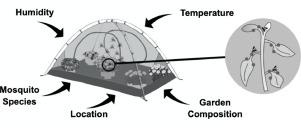Acta Tropica ( IF 2.7 ) Pub Date : 2020-07-07 , DOI: 10.1016/j.actatropica.2020.105624 Grace Pruett 1 , Julia Hawes 1 , Wendy Varnado 2 , Hunter Deerman 2 , Jerome Goddard 3 , Nathan Burkett-Cadena 4 , Christopher Kearney 1

|
Mosquitoes rely upon plant nectars for their energy needs, a trait that has the potential to allow nectar to serve as a platform for producing and delivering toxins to nuisance and/or vector mosquito species. Impatiens walleriana (Order: Ericales, Family: Balsaminaceae) is a readily transformable and widely planted nectar plant that has been previously shown to attract mosquito nectar-feeding. However, those feeding studies were only conducted indoors and did not test if variable environmental conditions will affect nectar feeding. In this study, we tested incidence of nectar feeding from the extrafloral nectaries of I. walleriana with the mosquitoes Aedes aegypti, Ae. albopictus and Culex quinquefasciatus (Order: Diptera, Family: Culicidae) in simulated, outdoor garden settings in Mississippi and Florida. I. walleriana and other common garden plants (in a 1:4 ratio) were placed into a mesh-lined 4’x7’ mesocosm along with 50 mosquitoes. To track nectar feeding, the nectar of I. walleriana was tagged with red dye and mosquitoes were analyzed for red dye fluorescence after feeding. Fluorescence analysis demonstrated that 81.9% of male and 86.6% of female mosquitoes fed on the nectar of I. walleriana within 24 hours. This suggests that mosquitoes may readily feed on impatiens nectar in outdoor garden settings at temperature and semi-tropical sites, even when alternate common garden plants are available. This attraction capacity is essential for the further consideration of I. walleriana for development as a transgenic, mosquitocidal nectar plant.
中文翻译:

在密西西比州和佛罗里达州的模拟室外花园环境中,易于转化的凤仙花有效地吸引了伊蚊和库蚊蚊虫的花蜜摄食。
蚊子依靠植物花蜜来满足其能量需求,这种特性可能使花蜜成为产生毒素并将其传递给讨厌的和/或媒介的蚊子物种的平台。Impatiens walleriana(订购:Ericales,家族:Balsaminaceae)是一种易于转化且广泛种植的花蜜植物,以前已被证明能吸引蚊子采食花蜜。但是,这些饲喂研究仅在室内进行,并未测试可变的环境条件是否会影响花蜜饲喂。在这项研究中,我们测试了蚊虫伊蚊,伊蚊从壁虎I的花蜜中获取花蜜的发生率。白化病和库蚊(顺序:双翅目,家庭:Cu科)在密西西比州和佛罗里达州的模拟室外花园中。I. walleriana和其他常见的园林植物(以1:4的比例)与50只蚊子一起放入有网眼衬里的4'x7'介观空间。为了追踪花蜜的摄食,用红色染料标记了瓦莱纳氏花蜜的花蜜,并在摄食后对蚊子的红色染料荧光进行了分析。荧光分析表明,以棉铃虫(I. walleriana)的花蜜为食的雄性蚊子为81.9%,雌性蚊子为86.6%。24小时内。这表明即使在有其他常见的园林植物的情况下,蚊子也可以在温度和半热带地区的室外花园环境中以凤仙花蜜为食。这种引诱能力对于进一步考虑沃勒单胞菌发展为转基因,灭蚊的花蜜植物至关重要。



























 京公网安备 11010802027423号
京公网安备 11010802027423号